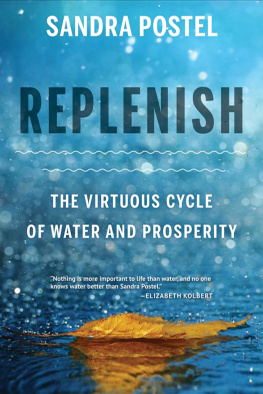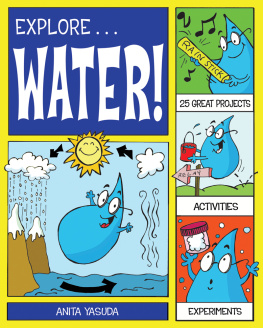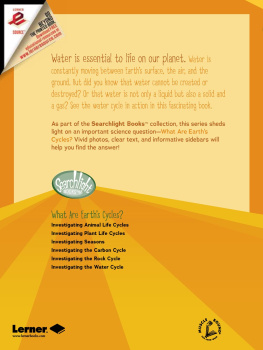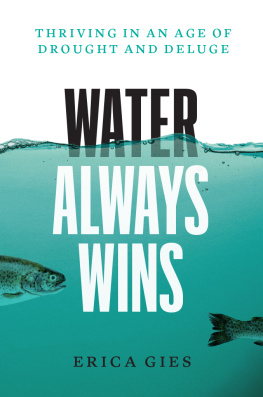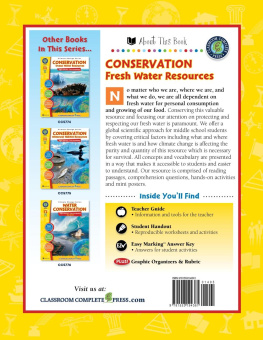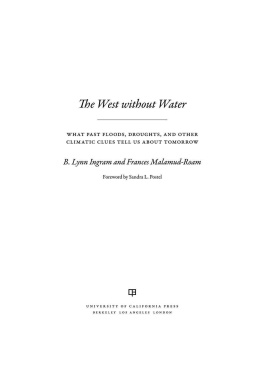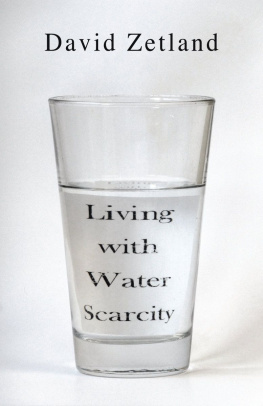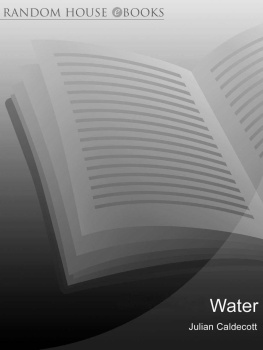All rights reserved under International and Pan-American Copyright Conventions. No part of this book may be reproduced in any form or by any means without permission in writing from the publisher: Island Press, 2000 M Street NW, Suite 650, Washington, DC 20036.
Island Press is a trademark of The Center for Resource Economics.
All Island Press books are printed on environmentally responsible materials.
Keywords: drought, floods, wildfire, climate change, wastewater, irrigation, dams, rain capture, regenerative agriculture, restoration.
Chapter 1
Water Everywhere and Nowhere
In water that departs forever and forever returns, we experience eternity.
Mary Oliver
As I wound my way up Poudre Canyon in northern Colorado, the river flowed toward the plains below, glistening in the midday sun. It ran easy and low, as it normally does as the autumn approaches, with the snowmelt long gone. I was struck by the canyons beauty, but also by the blackened soils and charred tree trunks that marred the steep mountains all around. They were legacies, I realized, of the High Park Fire that had burned more than 135 square miles (350 square kilometers) of forest during the previous years drought. It was September 7, 2013, and my family and I were heading to my nieces wedding. Tara and Eric had chosen a spectacular place for their nuptialsSky Ranch, a high-mountain camp not far from the eastern fringe of Rocky Mountain National Park. As we escorted my elderly parents down the rocky path to their seats, I noticed threatening clouds moving in. They darkened as the preacher delivered his homily. Please cut it short and marry them, I thought to myself, before we all get drenched.
The rains held off just long enough. But that days brief shower was a prelude to a deluge of biblical proportions that began four days later. A storm system stalled over the Front Range and in less than a week dumped nearly a years worth of precipitation in some areas. The Poudreshort for Cache la Poudreflooded bigger than it had since 1930. The torrential rains washed dead tree trunks down the hillsides into the raging river below. One canyon resident wrote that the blackened logs looked like Tinker Toys amid the rivers mad rush.
The threefold punch of drought, fire, and flood wreaked even worse havoc in neighboring mountain canyons, including that of the Big Thompson, a river renowned for the devastating flood of 1976. While that flood took 144 lives, it was relatively localized. This 2013 flood was vast, covering most of Colorados Front Range and affecting not only high-elevation towns from Boulder to Estes Parka number of which experienced a 1-in-500-year stormbut the heavily populated plains from Colorado Springs north to Fort Collins. Though by no means the deadliest, with eight lives lost, it became one of the costliest flood events in Colorados history. It triggered 1,300 landslides, damaged some 19,000 homes and commercial buildings, required the evacuation of more than 18,000 people, damaged 27 state dams (and completely took out a handful of low-hazard dams), and damaged or destroyed 50 bridges and 485 miles (780 kilometers) of roads. Losses were estimated to total some $3 billion.
Floods of this magnitude, while rare overall, are completely unexpected in Colorado in the very late summer. In river systems fed by melting snows, the biggest floods normally occur in the spring, as temperatures warm and snowmelt pours into headwater streams and the rivers they feed. Intense summer thunderstorms occasionally create localized flooding in July or August, but by September rivers are typically running low, just as the Poudre was when I drove up the canyon.
Brad Udall, a water and climate expert at the University of Colorado in Boulder, whose house sits just 30 feet (9 meters) from a creek thats normally dry in September, saw the creek turn into a raging stream. This was a totally new type of event, Udall told National Geographic, an early- fall, widespread event during one of the driest months of the year.
So often these days water seems to be nowhere and everywhere all at once. The wild weather of 2015 became almost legendary, even before the year was over. With raging floods in Latin America, the US Midwest, and the United Kingdom, and withering droughts in eastern and southern Africa, most of California and southeastern Brazil, terms such as anomalous, historic, and epic dominated the weather lexicon. US scientists determined that during one rare October rainstorm 17 streams in the US state of South Carolina broke records for peak flow. According to the United Nations, two years of drought left nearly 1 million African children suffering from acute malnutrition, and millions more at risk from hunger, water shortages, and disease.
Although the weather phenomenon known as El Nio became the go-to explanation for the global turmoil that year, this periodic event was not fully to blame. The El Nio came atop long-term warming trends that are fundamentally altering the movement of water across the planet. The earth was hotter in 2016 than since record keeping began in 1880. The previous record was 2015, which itself had beaten the previous record of 2014 by a considerable margin. For the contiguous United States, 2016 marked the twentieth consecutive year that the annual average temperature was higher than the twentieth-century average.
As air warms, it expands, which allows it to hold more moisture. This, in turn, increases evaporation and precipitation, which generally makes dry areas drier and wet areas wetter. If disasters related to droughts, floods, and other extreme weather seem more common globally, its because they are: according to a United Nations study, between 2005 and 2014, an average of 335 weather-related disasters occurred per year, nearly twice the level recorded from 1985 to 1995.
If we dont adapt to these new circumstances, a future of more turmoil is bound to unfold. The 6,457 floods, storms, droughts, heat waves, and other weather-related events that occurred over the last two decades caused 90 percent of disasters during that period. Those disasters claimed more than 600,000 lives and cost more than $1.9 trillion, according to the UN study. The countries hit with the highest number of disasters over the twenty-year period were the United States, with 472, and China, with 441, followed by India, the Philippines, and Indonesia.
Meanwhile, extreme weather is also affecting our food supply. A team of Canadian and UK scientists found that from 1964 to 2007 droughts and heat waves had each slashed the production of cereals by about 10 percentand by 20 percent in the more-developed countries. Altogether, the loss was estimated at 3 billion tons.
Leaders in business and government are beginning to take notice. More than 90 percent of companies in the S&P Global 100 Index see extreme weather and climate change impacts as current or future risks to their business. All five threats are intimately connected to water. Guarding against each requires a new understanding of our relationship to freshwaterand a new way of thinking about how we use, manage, and value it.

Water is unlike any other substance. It is always on the movefalling, flowing, swirling, infiltrating, melting, condensing, evaporatingand all the while knitting the vast web of life together. Through its endless circulation, water connects us across space and time to all that has come before and all that is yet to be. Our morning coffee might contain molecules the dinosaurs drank.

